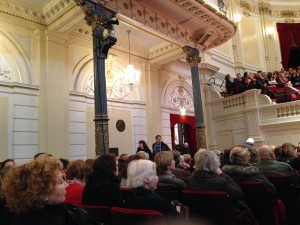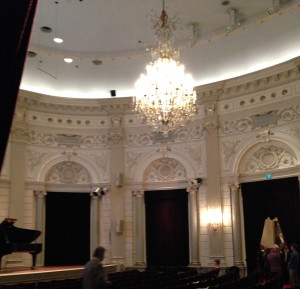Yes, you can go to the world-reknowned Concertgebouw without spending a fortune (a) if you are in Amsterdam on a Wednesday and are willing to stand in line — or (b) sometimes through Last Minute Tickets. That said, if you want to be sure of a seat you should book from home here. Many concerts are sold out weeks in advance to subscribers, but it’s always worth showing up at the Box Office and trying.
As you enjoy the beauty, don’t forget that the Concertgebouw was forced to fire its Jewish musicians and play music by non-Jewish composers, and it was the site of an early Nazi speech that warned non-Jews to abandon their fellow citizens. Read about it here.
There are two halls, each one remarkable in its own way, each sometimes the site of the free concert. Tours are offered right after the free Wednesday concert as well as at several other times; book here. Just seeing the lobbies with the chandeliers is a joy.
The Grand Hall: A Treasure Chest If you love classical music, hearing one of the world’s greatest orchestras in its acoustically glorious home venue is an irreplaceable experience.

About once a month except in July and August, the Royal Concertgebouw Orchestra plays for half an hour for anybody who’ll stand in line long enough to get into the Grand Hall. (Please note that other performers also play free concerts on Wednesdays at the Concertgebouw at 12:30.) We arrived on a freezing January Wednesday at 11:30, just an hour ahead, wondering if it would be enough. The weather and small visitor population, however, were in our favor.
“Is this the line for the lunchtime concert?” I asked an older man who was clutching his wool coat collar closed. He replied, “This is the cold line.” The warm line was inside, but much longer. At least it wasn’t raining, even if the wind was straight from the steppes of Siberia. About a hundred people were already huddled together, and we joined the edge, and soon felt the warmth of newer arrivals behind us.
Every Seat Full After we’d stamped our feet for an eternity or so, the doors opened, and the normally well behaved Dutch public squeezed forward ruthlessly. We were in! Only fifteen rows from the front, on the correct side to see the pianist. In the ten minutes it took for both lines to enter, every one of the almost 2,000 red velvet seats in the hall was full, all the way to the rafters. The setting is calm ivory and pale green touched with gold, the names of great composers above columns and swirling classical designs. When you go, be sure to look around.

The Recital Hall: A Jewel Box
Any chance to go to the Recital Hall at the Concertgebouw is worth snatching. It is a jewel box to be relished, especially at half price. The same morning as the concert, I signed onto the website of Last Minute Tickets right at 10:00. After a wait (be patient!), I snagged a pair of tickets to a piano recital with the mysterious title “Music, Imagination, and the Brain.” Note that many concerts are sold out, some months in advance, in which case your best hope is to show up at the regular box office and beg.
To get to the Recital Hall, you arrive at the brightly lit building and climb up a couple of open flights of stairs. They float in the modern addition to the 19th century building, so you first look up, then down, at a stunning contemporary chandelier.

The richest plum velvet curtains you’ve ever seen are parted so you can come into a space unlike any other. It’s like being inside a Fabergé egg, except that the small room is a perfect oval.

Concertgebouw Recital Hall
“Small” means that there are about 20 rows of curved seats, with a balcony above holding a few more (it too is an oval). In other words, it’s you and the musicians and only 436 other people, in a space that’s 66 feet long and 50 feet wide. If you’ve ever sat in a big theatre balcony and looked for the performers in the far distance, this is the perfect antidote, a paradise for those who love piano or chamber music.
Curved Woodwork Almost all the woodwork had to be bent to create the feeling of being held inside cupped hands — a skill cultivated over centuries among the shipbuilders in Amsterdam, easily shifted to building in the 1880s. How could subtly varied shades of ivory and grey tinged with gold be so elegant, and so interesting? Only the plum curtains were a real color, and yet the effect was palatial and rich. Even if you’re more interested in interior decoration than in music, this you have to see.
